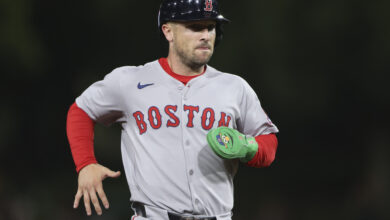
Very Early Results Support Initial Thoughts About Cubs’ Offense, Except for One Aspect
This shouldn’t come as a surprise to anyone, but the Cubs have shown here in the very early going that their offseason attempts to overhaul the offense have worked. I don’t mean that in terms of having a successful offense because that remains to be seen, only that the style Jed Hoyer sought to mold through multiple transactions appears to be playing out according to plan. And yes, I do realize they’ve only played five games.
Ed. note: For those who will undoubtedly fuss about it being too early and don’t I have anything better to write: Yes and no. The Cubs were rained out Wednesday and they’re off Thursday, so salient topics are kind of at a premium right now.
That said, we’re seeing a team that should hit for a higher average and reach base more frequently while also producing a good deal less power than we’ve seen in recent years. The on-base skills don’t necessarily come from patience, but from putting more balls in play and perhaps benefiting from the new shift restrictions. While it’s possible we’ll see the power numbers rise along with temperatures throughout the summer, the Cubs figure to stick pretty close to the proposed blueprint.
Their .273 average through 199 plate appearances would be their best mark since 2018 by 15 points and their 19.1% strikeout rate would top 2016 by two points. The Cubs haven’t reached base at a .343 clip since ’16 and their 103 wRC+ is just three points off the pace of that title campaign. Maintaining a 9.0% walk rate would leave them tied for sixth among the iterations of the roster since the breakout 2015 season.
Where we really see the separation on the other end is with a .125 ISO — a measure of raw power that tells you how often players hit for extra bases — that currently sits 23 points below last season for their lowest in the last nine years. Their .398 slugging percentage is actually tied for sixth with the ’15 squad, but that’s just because they’re reaching more often via base hits.
We could dismiss most of these results as the function of a small sample size, and maybe that’s what’ll happen over time, but the stats are all tracking along the exact path Hoyer laid out. It’s more like following a paper map rather than GPS, however, so there will be some little detours and deviations along the way. One of those, perhaps the most surprising, is the apparent lack of aggressiveness on the bases so far.
The Cubs have just three stolen bases through five games, putting them right around the middle of the league in that category. That kind of risk aversion typified their years of contention, but the Cubs were one of the top teams in the league when it came to swiping bags and it stood to reason that they’d be up there again this year. Or it still stands because they can’t rely on getting 16 hits every night.
Nor can they necessarily expect to continue hitting at this high a clip, so putting runners in motion is going to be a necessary part of whatever level of success they achieve. It’s even stranger that they’re not running more in light of David Ross‘s decision to have Patrick Wisdom bunt the other night, but whatever.
Those who might be concerned with the premature nature of this analysis can rest assured that I’ll continue to check back on it over the next few months.

